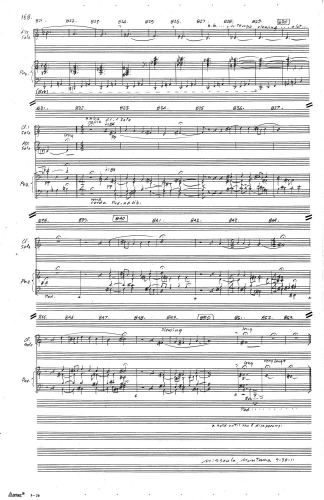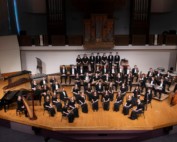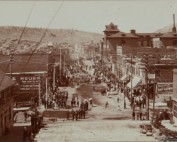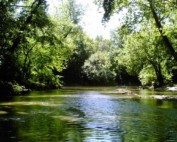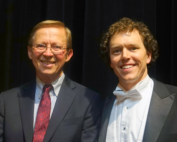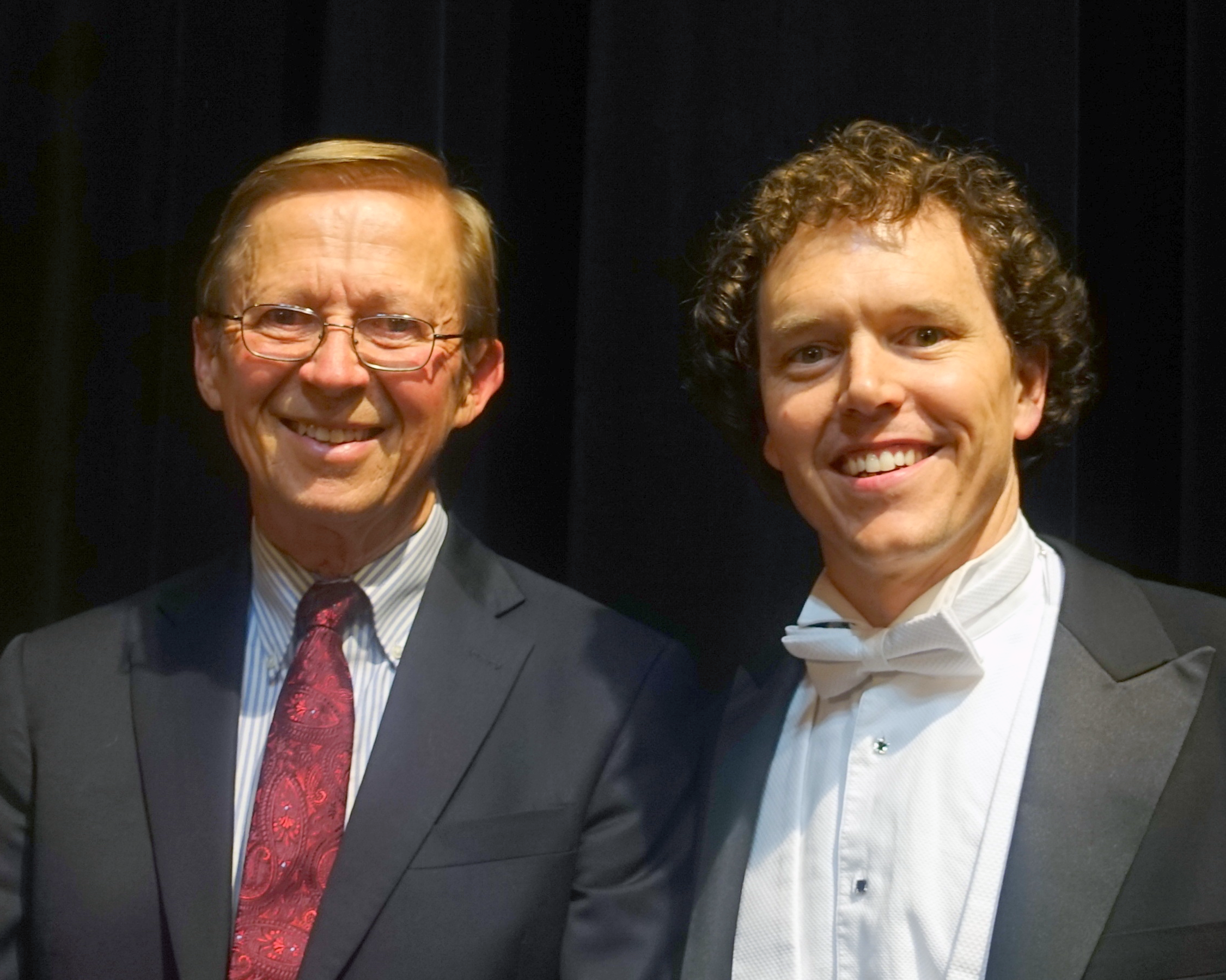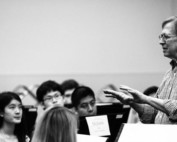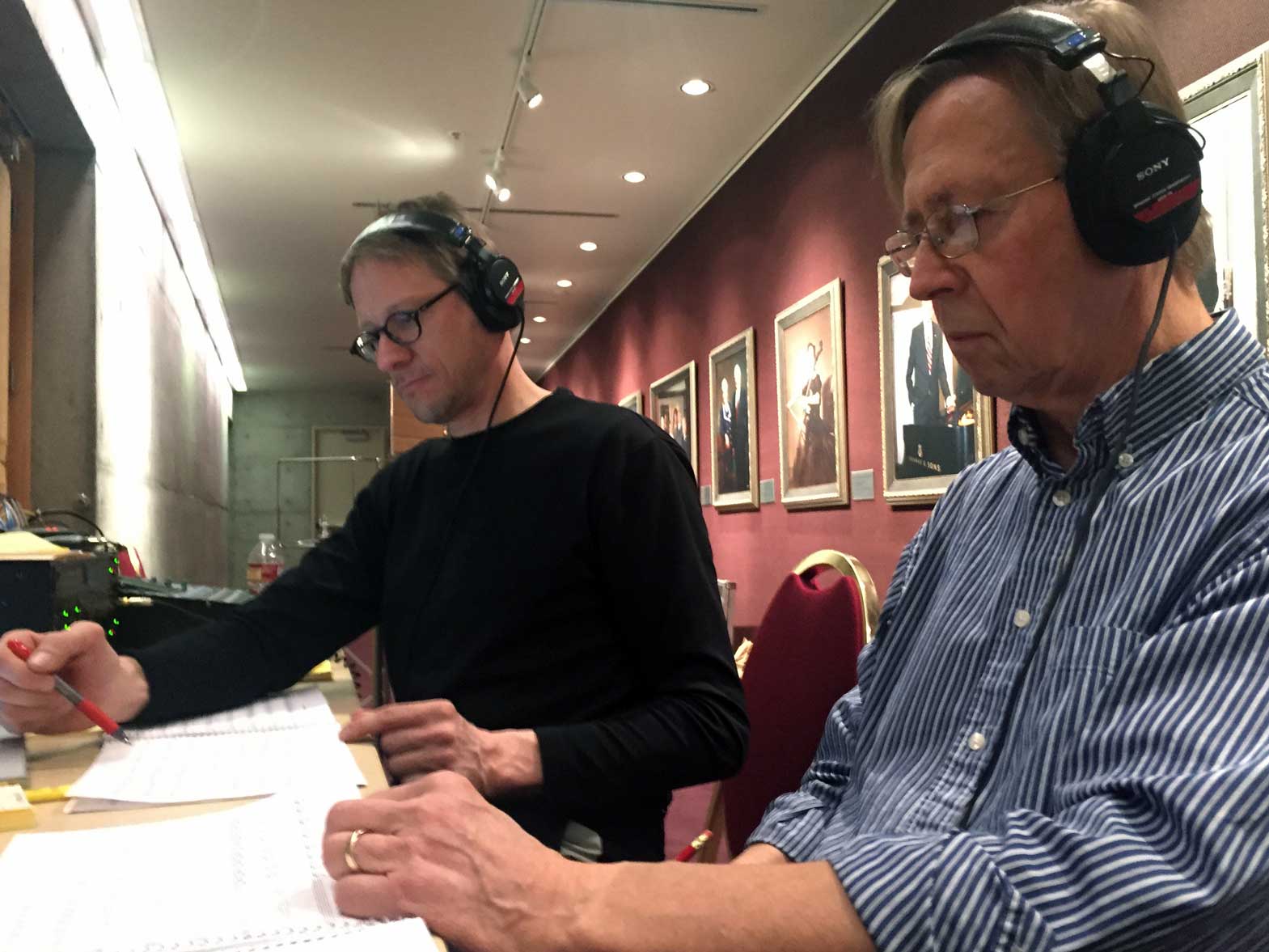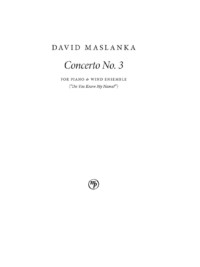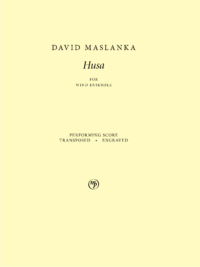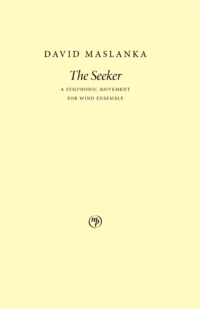Project Description
Wind Ensemble2011
75 min.
Grade 7
Listen Now
Illinois State University Wind Symphony, Stephen Steele, cond.
On the album David Maslanka: Symphony No. 9 (2012)
Instrumentation
Narrator Picc Fl-2 Ob-2 EbCl BbCl-3 BCl CbCl Bsn-3(3»Cbsn) SSx ASx-2 TSx BSx | Hn-4 Tpt-3 Tbn-2 BTbn Euph Tuba DB | Hp Pno Timp Perc-6
- Narrator
- Piccolo
- Flute (3)
- Oboe (2)
- Clarinet in Eb
- Clarinet in Bb (3)
- Bass Clarinet
- Contrabass Clarinet in Bb
- Bassoon (3), 3rd dbl. Contrabassoon
- Soprano Saxophone
- Alto Saxophone (2)
- Tenor Saxophone
- Baritone Saxophone
- Horn in F (4)
- Trumpet in Bb (3) (st., Harm., plunger)
- Trombone (2)
- Bass Trombone
- Euphonium
- Tuba
- Double Bass
- Harp
- Piano
- Timpani (4 drums)
- Required Percussion 6 Players
- Xylophone
- Crotales
- Marimba (3)
- Chimes
- Suspended Cymbal (lg.)
- Snare Drum
- Tenor Drum
- Bass Drum (2)
- Tam-tam
Commissioned by
Commissioned by a consortium lead by Stephen K. Steele, Illinois State University.
- Steven Ward
Abilene Christian University - James Lambrecht
Augustana College - Bruce Moss
Bowling Green State University - Donald Peterson,
Brigham Young University - Wesley Broadnax
California State Univeristy - Gary Gilmore
California State University Fresno - Larry Gookin,
Central Washington University - Mark Scatterday
Eastman School of Music - Richard Clary
Florida State University - Robert Dunham
Georgia Southern University - Christopher Werner
La Crosse
Public Education Foundation (LPEF) - Nathan Rinnert andAdam Brennan
Mansfield University - David Kish
Metro State Department of Music - Reed Thomas
Middle Tennessee State University - Warren Olfert
Reineke Fine Arts Center - Craig Fuchs
Pittsburg State University - Kraig Williams
Rutgers University - Joseph Hermann
Tennesse Tech University - Bobby Francis
Texas Christian University - Caroline Beatty
Texas State University - Kenneth Ozzello
University of Alabama - C. David Ragsdale
University of Alabama in Huntsville - Gregg Hanson
University of Arizona - Brian Lamb
University of Central Oklahoma - John Cody Birdwell
University of Kentucky - Martin Seggelke
San Francisco State University - Carolyn Barber
University of Nebraska–Lincoln - John Carmichael
University of South Florida - Thomas Fraschillo
University of Southern Mississippi - Jerry Junkin
University of Texas at Austin - Doug Stotter
University of Texas at Austin - Peter J. Haberman
University of Wisconsin-Eau Claire - Scott Hagen
University of Utah - Terry Austin
Virginia Commonwealth University - Mark Norman
Washburn University - Robert Spradling
Western Michigan University - Martin Lenard
Kerrville, TX Independent School District - Luis DeLaCruz
McCollum High School Band - Nakata Mamoru
Tokyo Kosei Wind Orchestra
Premiere
11 November 2011 by the Illinois State University Wind Ensemble, Stephen K. Steele, cond., at the Illinois State University Center for the Performing Arts, Bloomington-Normal, IL
Difficulty
Advanced College/Professional Band.
Most sections have exposed solo and chamber playing. The Soprano and Alto Saxophone, Clarinet Choir, and Piano are especially prominent. Requires advanced mallet percussion.
Completion
30 September 2011, Missoula, Montana
“…what an extraordinary creation he has here…”
—Zan Furtwangler, Audiophile Audition
Description
This work was commissioned by Dr. Stephen K. Steele of Illinois State University who gathered a consortium of over 40 conductors, ensembles, and individuals, here and abroad, to support the work. It is in four movements, with a duration of about 75 minutes. The symphony opens with a reading of the poem “Secrets” by W. S. Merwin, which is paralleled in the fourth movement by a reading of my brief Whale Story. Symphony No. 9 can be described as a large collection of instrumental songs which create a continuously moving tapestry of thoughts and images relating to the nature of memory, the life giving creative force of water, and compassion, forgiveness, and rest. The flow of the entire Symphony is toward the Chorale melody O Sacred Head Now Wounded at the end of the fourth movement. While the Symphony is of extended length it is not physically fatiguing to perform. Its high demand is for patience in pacing, and continuous attention by all ensemble members to each moment of musical sound.
Movements
- Preface: “Secrets” by W.S. Merwin
- Shall We Gather at the River
- Now All Lies Under Thee
- Fantasia on I Thank You God…
- Fantasia on O Sacred Head Now Wounded
Shall We Gather at the River
Watch the Night With Me
Soul, How Have You Become So Unhappy
Whale Story (O Sacred Head Now Wounded)
O Sacred Head Now Wounded
Program Note
Symphony No. 9 is a large collection of instrumental songs. There are many influences and underlying elements, but most of them cannot be explained in words. Rather than try, I will simply list some of the things at work:
Time: memory, passing of time, “We flew through the years hearing them rush under us” —W.S Merwin
Water: cleansing and life–giving power, Shall We Gather at the River, Whale Story
Nature: our ground, river, ocean, chickadees
Grace: compassion, forgiveness, rest
The Symphony begins with a reading of the poem “Secrets”* by W.S. Merwin.
Time unseen time our continuing fiction
however we tell it eludes our dear hope and our reason
that is a pure condition of the story
and wherever our parents came from is another century
an age which they themselves could barely remember
but carried with them as their own year after year
hidden away hardly looked at until the secret
without their noticing had faded all the details white
for my mother it came to be the lace veil covering
the front of the baby carriage where she was being
wheeled through the Garden of the Gods when her parents were
still alive as she told about it later
and for my father it was the glare bleaching the surface
of the river as he sat under the white blaze
of summer in the rowboat tied above the waterline
where he was allowed to hold the oars and imagine
leaving did he see any farther when he was
dying in summer after midnight and before the solstice
coughing saying he was not afraid and was the veil still there
when my mother turned from her own garden one evening that same year
telling a friend on the telephone that she was going
to get a little rest now at her glasses were lying
apart from her on the floor not more than an hour
later when a neighbor pushed the door open and found her
Each movement embodies one or more chorale melodies or other songs. In the fourth movement, There is a reading of my own Whale Story (O Sacred Head Now Wounded).
I. Shall We Gather at the River
I Thank You God for All Your Good Works †
II. Now All Lies Under Thee †
III. Fantasia on I Thank You God… †
IV. Fantasia on O Sacred Head Now Wounded †
Shall We Gather at the River
Watch the Night With Me (fl., tpt, harp, pno.)
Soul, How Have You Become So Unhappy † (fl., tpt, sax., harp, pno.)
Whale Story (O Sacred Head Now Wounded)
Why should God have incarnated only in human form? (A brief story about whales)
In the sixty million years or so the great whales have had, both on land and in the oceans, there have been numerous, and in fact, innumerable great beings among them. In fact, it turns out that all the great whales are either highly developed bodhisattvas or Buddhas. And in fact, it turns out that the Earth’s oceans are a Buddha Pure Land, and when you pass from this existence it is to be hoped for rebirth as a god or a great whale. In fact, it turns out that the Pure Land oceans of the Earth are a training ground for Buddhas across all space and time. We are loved by the great whales, and they, serenely riding the waves of birth and death, will die for us so that we may come to our enlightenment.
The end.
O Sacred Head Now Wounded † (cl., sax., harp, pno., perc.)
†Chorale melodies are from the 371 Four-part Chorales by J.S. Bach
Further Reading
Maslanka Weekly: Best of the Web – No. 91, David’s Symphonies Around the World
Maslanka Weekly highlights excellent performances of David Maslanka’s music from around the web. This week, we travel from the corn fields of Iowa - to the exciting streets of Paris - to the historic sights of northern Portugal to feature three new performances of favorite symphonies: Symphony No. 9, Symphony No. 10, and Symphony No. 5.
From the Maslanka Archive – No. 8, World Premiere of Symphony No. 9
From the Maslanka Archive features media and stories of David's life and work. This week, we are excited to feature pictures from David's residency with Stephen K. Steele at Illinois State University prior to the World Premiere of David's Symphony No. 9 by the Illinois State University Wind Symphony.
Maslanka Weekly: Best of the Web – No. 87, Grace
Maslanka Weekly highlights excellent performances of David Maslanka’s music from around the web. This week, we feature three of David’s compositions that offer various glimpses of grace: Requiem, Symphony No. 9, and Traveler.
Maslanka Weekly: Best of the Web – No. 83, Old America
Maslanka Weekly highlights excellent performances of David Maslanka’s music from around the web. This week, we feature performances of three works that contain themes of Old America: California, “Nighthawks” from This is The World, and "Shall We Gather at the River" from Symphony No. 9.
Maslanka Weekly: Best of the Web – No. 47, Rivers
Maslanka Weekly highlights excellent performances of David Maslanka’s music from around the web. This week, we feature three of David’s compositions that make reference to a river: Symphony No. 9, Movement I, "Shall We Gather at the River," Symphony No. 2, Movement II, "Deep River," and Symphony No. 10: The River of Time, Movement II, "Mother and Boy Watching The River of Time."
Maslanka Weekly: Best of the Web – No. 20, O Haupt voll Blut und Wunden
Maslanka Weekly highlights excellent performances of David Maslanka’s music from around the web. This week, we feature phenomenal performances of Symphony No. 9, Hohner, and Tone Studies.
Maslanka Experiences: Sam Ormson
Playing Symphony No. 9 with a high school band was supposed to be impossible. Sam Ormson writes about his musical development through David's music.
David Maslanka: Works for Younger Wind Ensembles
Here are more than twenty works for wind ensemble, arranged in approximate ascending order of difficulty, with commentary by David Maslanka
Recording the Wind Ensemble Music of David Maslanka
Mark Morette of Mark Custom Recording shares his extensive experience in recording wind ensembles.
David Maslanka and the Natural World: Three Studies of Music for Wind Ensemble
Kate Sutton's Master's thesis is a study on David's Third, Fourth, and Ninth Symphonies with special emphasis on their themes on nature. She explores the influence that moving to Missoula, Montana had on David for Symphony [...]
